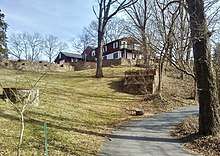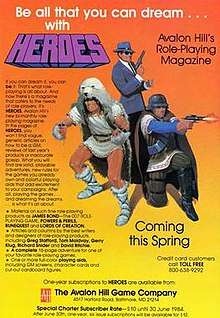Avalon Hill
Avalon Hill Games Inc. is a game company that specializes in wargames and strategic board games. Its logo contains its initials "AH", and the company is now often referred to by this abbreviation. Before its takeover by Hasbro, it was known as The Avalon Hill Game Company and the initials TAHGC. It has also published miniature wargaming rules, role-playing games and sports simulations. It is now a subsidiary[1] of the game company Wizards of the Coast, which is itself a subsidiary of Hasbro.[2]
 | |
| Subsidiary[1] | |
| Founded | 1952 in Baltimore, Maryland |
| Headquarters | , United States |
| Products | Board games |
| Owner | Hasbro |
| Parent | Hasbro Interactive (1998–2001) Wizards of the Coast (2004–present) |
| Website | avalonhill |
Avalon Hill pioneered many of the concepts of modern recreational wargaming. These include elements such as the use of a hexagonal grid (a.k.a. hexgrid) overlaid on a flat folding board, zones of control (ZOC), stacking of multiple units at a location, an odds-based combat results table (CRT), terrain effects on movement, troop strength, morale, and board games based upon historical events. Complex games could and did take days or even weeks, and AH set up a system for people to play games by mail.[3][2]
History
The Avalon Game Company

Avalon Hill was started in 1952 outside Baltimore in Catonsville, Maryland by Charles S. Roberts under the name of "The Avalon Game Company" for the publication of his game Tactics. It is considered the first of a new type of war game, consisting of a self-contained printed map, pieces, rules and box designed for the mass-market.[3][4] Other war games published over the prior half-century, which Roberts drew inspiration from, were either not designed for the commercial market and/or used miniatures with self-made maps/terrain.[5] Roberts sold Tactics by mail from his home in the Avalon neighborhood of Catonsville; his house overlooked the B&O railroad for which Roberts, his father and grandfather worked.[4] Following the success of Tactics, Roberts changed the name upon incorporation from "The Avalon Game Company" to "Avalon Hill" in 1958 because of a naming dispute with another company.[3] The number of games released per year was erratic until 1964 as the company released anywhere from 1 to 7 games.[4]5-8
The first game published by the company under the name of "Avalon Hill" was the second edition of Tactics, titled Tactics II, published in 1958.[3][6] AH published two other games that year, Gettysburg and the railroad game Dispatcher.[3]
In 1959, Roberts moved Avalon into an office space on Gay Street in Baltimore and took on its first outside designed game, Verdict, by two corporate lawyers. After another office move, in August 1960 Thomas N. Shaw, a high school friend of Roberts, was hired to design games.[3][4]6
In 1960, Avalon published the first mostly dice-less sports game in Football Strategy designed by Thomas N. Shaw which was followed by two sister games, Baseball Strategy and Basketball Strategy.[7][8] Of this sports strategy line, the football and baseball versions were previously privately published by Shaw in 1959.[4]7 With a recession occurring, debt began to pile up starting in 1961.[3] (A computer game version, Computer Football Strategy, was published by Avalon Hill in 1983.)
Avalon launched a pre-school children's line in 1963 with four games, Imagination, What Time Is It?, Doll House and Trucks, Trains, Boats & Planes, which flopped. Roberts gave up and planned to file bankruptcy on December 13, 1963.[4]p7 Instead his creditors, Monarch Office Services and J.E. Smith & Co. interceded and took over. Monarch had printed all but the boxes, which were done by J.E. Smith.[9]:175 The company was reorganized by retaining only one staff member, Shaw, moved, cut costs and appointed J.E. Sparling as president.[4]p7,8 In 1964, AH set a two-game per year release schedule.[4]5-8
Avalon Hill published Blitzkrieg in 1965. This game was an abstract combat game, featuring two sides (red and blue) and some neutral countries. Many rules variants were created for Blitzkrieg. The company also published simulations of actual battles and campaigns, such as Midway, Afrika Korps, and The Battle of the Bulge.
Avalon Hill published PanzerBlitz in 1970, designed for the company by Jim Dunnigan's Simulations Publications, Inc. (SPI) on a royalty basis from SPI's Tac Force 3 game.[4]p9
Monarch Avalon division
Monarch bought out J.E. Smith & Co., Avalon Hill's co-owner, on November 30, 1971. Thus the company became a division of a renamed Monarch Office Services, Monarch Avalon.[4]p10
The company acquired several successful games including Acquire, TwixT and Feudal from the purchase of 3M Games in February 1976.[4]p5,12[10] Sports Illustrated (SI) line of sports games were purchased in December 1976. Both lines increased the retail outlets that would take AH games. The Aladdin Industries game line was another acquisition in March 1977. With the SI line, the company started a sports game division in May 1977 with Bruce Milligan hired to head the division and launch All Star Replay sport games magazine. While from the 3M line, Facts in Five became its top selling game.[4]p5,12
During the 1970s, the company's golden years, Avalon Hill published a number of popular games such as Outdoor Survival, Panzer Blitz, Squad Leader, and the Statis Pro sports line.[3]
Avalon Hill also purchased many games from smaller companies and republished them. Heritage Models sold AH its Battleline Publications in October 1979.[4]p5,15 Much of the Battleline line, including Wooden Ships and Iron Men and Machiavelli (a variant of Diplomacy set in Renaissance Italy), was republished by Avalon Hill, along with the popular Diplomacy. AH also acquired Jedko Games' The Russian Campaign and War at Sea, and Hartland Trefoil's Civilization. 1830 was developed by Avalon Hill, but based on Francis Tresham's 1829.
In 1974, a new game developer attempted to pitch his concept to Avalon Hill. Gary Gygax and Dave Arneson had co-developed a new type of co-operative game that used role-playing. But when Gygax pitched Dungeons & Dragons to AH, the largest company in wargaming did not understand the concept of role-playing, and turned down his offer.[11] Gygax was forced to form TSR Inc in order to self-publish his game. In less than five years, TSR would be the dominant player in the new RPG market.
Avalon Hill finally entered the role-playing game market a decade later by publishing Powers and Perils in 1983 and Lords of Creation in 1984.[12] The licenses to RuneQuest and the board games White Bear & Red Moon (republished as Dragon Pass) and Elric, were acquired in a complex agreement in 1983 with Chaosium, and Avalon Hill published the 3rd Edition in 1984.[13][14] None of these role-playing games achieved the popularity of the long-established competitor, Dungeons & Dragons.
Avalon Hill became an early publisher of computer games in 1980[15] with its video game division Microcomputer Games, adapting some of its boardgame titles to various computer platforms (TRS-80, Vic-20, Commodore 64, Apple II, etc.) on several data formats (cassette tape and 5¼" disk). Sales of these products were decent, but the only outstanding success was Achtung Spitfire!, published relatively late in the company history.
Gulf Strike was introduced by the company in 1983 and was based on the Iran–Iraq War then updated after the cease-fire in 1988. AH published The Dr. Ruth Game in 1985 which sold initially well then dropped off.[16]
Facing an economic downturn in 1990 and a three year period of losses, Monarch Avalon closed its New York office, sold its toy division and reduced inventory. AH also published its timely game expansion, Desert Shield, that sold out in weeks after its October 1990 release such that a second print run hit the market in December 1990.[17][18] In 1991, Hobbycraft Canada was sharing office space with Monarch Avalon.[16]
AvalonCon World Boardgaming Championships was first held by AH in 1991.[19]
In December 1992, AH hired Jim Rose to lead its computer game division,[20] with the goal of reviving this part of the business in the face of flagging board game sales.[21] AH reentered the computer game market in 1994 with a good review of "Flight Commander 2". The company added Pogs to its game line up in 1995.[22] By June 1995, Rose had left the company to found TalonSoft.[23] In 1995, Monarch Avalon placed Avalon Hill up for sale but it was later withdrawn.[24]
Hasbro subsidiary
Monarch sold Avalon Hill to Hasbro Games on August 4, 1998 for $6 million.[25] Hasbro, largely seeking a computer gaming software company and known games to convert to interactive computer games per an Arcadia Investment Corp. investment analyst, purchased the rights to the Avalon Hill trademarks, copyrights, inventory, tooling and divisions, Avalon Hill Software and Victory Games.[24] Avalon Hill Games, Inc. was incorporated by Hasbro on March 2, 1998.[1][2]
Avalon was transferred to the control of Wizards of the Coast, another Hasbro subsidiary, in 2004.[10]
In 2000, Avalon released a redesigned edition of Cosmic Encounter in cooperation with its owner/developer Future Pastimes. This edition was not well received by players and Avalon did not follow up with any of the expected expansion sets.
Hasbro has released new titles under the Avalon Hill name, and added the Avalon Hill imprint to older titles such as Axis and Allies that were not originally made by Avalon Hill.
Game rights
The rights to many of Avalon Hill's more complex games have been licensed or sold to other game publishers, or have reverted to their original owners and been republished by other companies:
- Multi-Man Publishing acquired a license to Advanced Squad Leader and the Great Campaigns of the American Civil War series, and has since published new materials for these. (It also had the rights to Up Front for many years, but never released a new version of the game.)
- Valley Games published new versions of Titan, Hannibal: Rome versus Carthage, and Republic of Rome.
- GMT Games published new editions of Avalon Hill's early card-driven wargames We the People (retitled Washington's War), Successors, and For the People, and a descendant of Advanced Third Reich/Empire of the Rising Sun named A World at War.
- Mayfair Games now has the rights to 1830 (one of several 18XX games they publish).
Victory Games
In 1982 Avalon Hill hired some of the design staff from Simulations Publications, Inc. (SPI) after that company was purchased by TSR, Inc, and formed them into a subsidiary company, Victory Games. SPI had specialized in wargames that were more complex and realistic simulations than those that Avalon Hill published. It also published games more frequently than Avalon Hill, which stayed with its two-a-year schedule of releases long after SPI began publishing boxed games monthly and as inserts via the magazine Strategy & Tactics. When Victory Games released a line of SPI-style games, it met with critical and commercial acclaim. As employees gradually departed for other game companies or more lucrative careers in defense analysis and government wargaming, the staff of Victory Games's New York City office on East 33rd Street shrank dramatically. But contrary to some accounts, Victory Games was not "disbanded" in 1989. Rather, West End Games veteran Leonard Quam was brought aboard to breathe new life into the firm and hired Kevin Boylan as a product developer. Victory Games continued to develop and release new products (including 3rd Fleet and Carrier) for another three years, though the New York office closed in early 1991 after Quam left the company. Victory's final two games, Flashpoint Golan and Across Five Aprils, were developed by Boylan alone working remotely in collaboration with Avalon Hill's art department.[26]
Magazines
The General

Avalon Hill also had its own house organ which promoted sale and play of its games, The General Magazine, which was published regularly between 1964 and 1998. The magazine offered a wide array of features, including articles on both strategies of play and tactics for specific situations, historical analyses, semi-regular features devoted to individual games, columns on sports and computer games by AH, listings of vendors and opponents, answers to questions on game rules, ratings for both games and players, discount coupons for mail orders, and insider information on future AH projects.
Heroes
In early 1984, on the occasion of the release of third edition RuneQuest, Avalon Hill included in all RuneQuest boxes a single advertising flyer (see image, right) announcing the launch of HEROES, its own role-playing magazine. HEROES ran for ten issues from 1984 to 1986[27] and had the main purpose to promote all four of Avalon Hill's role-playing games: James Bond 007, Lords of Creation, Powers and Perils, and RuneQuest.
See also
References
- "Business Entity Summary: AVALON HILL GAMES, INC". Corporations Division Corporate Search. Massachusetts Secretary of Commonwealth. Archived from the original on September 23, 2015. Retrieved August 5, 2015.
- Carlisle, Rodney (2009). Encyclopedia of Play in Today's Society. SAGE Publications. p. 53. ISBN 9781452266107.
- Rienzi, Greg (May 2009). "Baltimore Observed: Encounter". The Urbanite Magazine. Urbanite Baltimore. p. 35. Archived from the original on June 8, 2009. Retrieved 2009-05-11.
- "The General Index and Company History". The General Magazine Index and Company History. 1980. Retrieved August 5, 2015.
- Matthew B. Caffrey Jr. (2019). On Wargaming: How Wargames Have Shaped History and how They May Shape the Future (PDF). Navel War College Press. pp. 77–78. Archived from the original on 2020-01-25.
- Arneson, Erik. "Tactics II". About Board/Card Games. About.com. Retrieved August 5, 2015.
- Arneson, Eric. "Football Strategy". About Board Games. About. Archived from the original on July 15, 2015. Retrieved July 15, 2015.
- Arneson, Eric. "Best Football Board Games". About Board Games. About. Retrieved 15 July 2015.
- Shannon Appelcline (2011). Designers & Dragons. Mongoose Publishing. ISBN 978-1-907702-58-7.
- Arneson, Erik. "Hasbro - Brief History". About Board Games. About.com. Archived from the original on 2008-04-15. Retrieved July 15, 2015.
- Hoffmann, Frank W.; Bailey, William G. (1991). Sports & Recreation Fads. Haworth Press. p. 109. ISBN 1-56024-056-3.
- Kim, John H. "RPG Company List: A: Avalon Hill". Role-Playing Game Companies. Retrieved August 5, 2015.
- Kim, John H. "R: RuneQuest". RPG Encyclopedia. Retrieved August 5, 2015.
- Appelcline, Shannon (September 4, 2006). "Chaosium: 1975-Present". A Brief History of Game (3). RPG.net. Retrieved August 5, 2015.
- Wilson, Johnny L. (November 1991). "A History of Computer Games". Computer Gaming World. p. 10. Retrieved 18 November 2013.
- Easton, Thomas (February 13, 1991). "Games on war, debt aimed at capturing public mood". Baltimore Sun. New York. Retrieved August 6, 2015.
- Singletary, Michelle (March 20, 1991). "Local firm's games sales aided by war". Baltimore Sun. Retrieved August 6, 2015.
- Clark, Kim (December 9, 1990). "Surviving tough economic times is no child's play for toy-makers Companies search for new markets". Baltimore Sun. Retrieved August 6, 2015.
- Keyser, Tom (August 7, 1994). "Game maker makes right move with convention". Baltimore Sun. Retrieved August 5, 2015.
- Rose, Jim (1993). "Silicon Simulations". The General. 28 (4): 57.
- Greenwood, Don (1994). "The Avalon Hill Philosophy Part 161: A Tale of Two Companies". The General. 29 (2): 3.
- "Monarch Counts On Pc Games". Baltimore Sun. February 17, 1995. Retrieved August 5, 2015.
- Emrich, Alan (June 1995). "Dealing with the Fog of War; G-2". Computer Gaming World (131): 153, 154.
- Leffall, J. (August 5, 1998). "Monarch Avalon to sell game unit to Hasbro In wake of loss, local company to get $6 million in cash". Baltimore Sun. Retrieved August 5, 2015.
- "The Fall of Avalon Hill". Archived from the original on 2016-01-29. Retrieved 2015-10-25.
- The Complete Wargames Handbook Archived 2006-10-31 at the Wayback Machine Chapter 5: History of Wargames - Into the 1980s
- HEROES review from Shannon Appelcline's website
